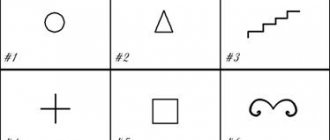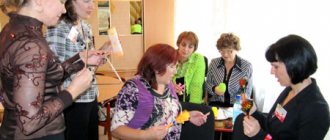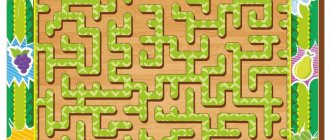“Speech development of preschool children in different types of activities”"
—Articulation gymnastics:
“Horse”, “Brushing teeth”, “Starting a motorcycle”, etc.)
— Compilation of descriptive stories;
— Development of
coherent speech through fiction.
Fiction is one of the main means
of child speech development
.
In classes on familiarization with fiction, it is necessary to introduce children to various genres of children's folklore, poems and stories. Much more often I tell them about writers, introduce them to the history of the work, and expand and complicate the children’s
.
Fiction develops
a child’s thinking and imagination, enriches his emotions and vocabulary.
— Visual activity
has great cognitive and educational significance.
Artistic creativity is a unique means for the development of
fine motor skills and speech in their unity and interconnection.
The more a child can, wants and strives to do with his hands, the smarter and more inventive he is. As fine motor skills improve, speech function develops
.
Hand function and speech develop in parallel
.
In the process of productive activity,
we teach children to analyze forms, observe, compare, and highlight similarities and differences in size of objects.
— Speech development
communication through
play activities
.
Through play, encourage children
to communicate with each other. And the role-playing game promotes:
- strengthening the skills of using initiative speech,
- improving conversational speech,
- enrichment of the dictionary,
-formation of the grammatical structure of the language, etc.
- Development
speech
through didactic games
.
The didactic game develops children’s speech
: it replenishes and activates the vocabulary, forms correct sound pronunciation,
develops coherent speech
, and the ability to correctly express one’s thoughts.
children's
vocabulary is enriched .
They are also used to consolidate children's
(nouns, adjectives, verbs, color names, spatial concepts, prepositions, etc.).
Speech
, memory, attention, logical thinking, visual memory develop. A culture of behavior and communication skills are strengthened.
— LACING, PUZZLES, MOSAIC.
Good helpers for the development of fine motor skills are:
1. Lacing toys - make it possible to come up with a lot of games;
2. Cubes and pyramids - develop not only fine motor skills and spatial thinking, but also attention and logic;
3. Constructors - develop spatial thinking, motor skills, and creative abilities;
4. Puzzles – provide an opportunity to develop attention, intelligence, logical thinking, coordinated work of the eyes and hands;
First, direct emotional communication, and then business cooperation, determine the child’s need for communication. Emerging in communication, speech first appears as an activity divided between an adult and a child. Later, as a result of the child’s mental development, it becomes a form of his behavior. The development of speech is associated with the qualitative side of communication.
In studies conducted under the leadership of M. I. Lisina, it was established that the nature of communication determines the content and level of speech development of children.
The characteristics of children's speech are associated with the form of communication they have achieved. The transition to more complex forms of communication is associated with: a) an increase in the proportion of extra-situational utterances; b) with an increase in general speech activity; c) with an increase in the share of social statements. A study by A.E. Reinstein revealed that with a situational-business form of communication, 16.4% of all communicative acts are carried out using non-verbal means, and with a non-situational-cognitive form - only 3.8%. With the transition to non-situational forms of communication, the vocabulary of speech and its grammatical structure are enriched, and the “attachment” of speech to a specific situation decreases. The speech of children of different ages, but at the same level of communication, is approximately the same in complexity, grammatical form and sentence development. This indicates a connection between the development of speech and the development of communicative activity. It is important to conclude that for speech development it is not enough to offer the child a variety of speech material - it is necessary to set new communication tasks for him, requiring new means of communication. It is necessary that interaction with others enriches the content of the child’s need for communication (See Communication and speech, speech development in children in communication with adults / Ed. M. I. Lisina - M., 1985)
Therefore, the organization of meaningful, productive communication between teachers and children is of paramount importance.
Speech communication in preschool age is carried out in different types of activities: in play, work, household, educational activities and acts as one of the sides of each type. Therefore, it is very important to be able to use any activity to develop speech. First of all, speech development occurs in the context of leading activity. In relation to young children, the leading activity is objective activity. Consequently, the focus of teachers should be on organizing communication with children during activities with objects.
Formative speech environment
The formative speech environment provides great opportunities for speech development.
Children can be encouraged to look at pictures, toys, books on their own, and tell them about these objects, as well as about various events. Using assignments, you can give children the opportunity to communicate with peers and adults. In order to develop initiative speech, it is necessary to provide children with the opportunity to independently talk about objects from their immediate environment. You also need to give children examples of how to address adults.
We will also discuss games and game exercises.
Subject games in speech development
Playing with toys or objects is used to develop tactile sensations, manipulate different toys and objects, and develop creative thinking and imagination. When children get acquainted with different parts of the body, I try to play the game “Ola’s Helpers.” In this game, children not only get acquainted with different parts of the body, but also learn to form the plural of verbs.
By playing “What is this object?”, preschoolers learn to name objects correctly. Children take objects out of the bag and name them. The game “Colorful Chest” is played in a similar way.
Children must take a picture out of the chest and name what is drawn on it.
To consolidate acquired knowledge and clear sound pronunciation, I use the game “Magic Cube”. Children throw dice so that they spin. Then the children depict what falls on the top edge and try to pronounce the appropriate sound.
To compare objects by size, we invite children to find their own plate for the three bears.
In order for children to remember the specific features of different animals and birds, the game “Whose fur coat is this?” is played.
Enrichment of vocabulary and vocabulary
Vocabulary development is carried out with the help of different subjects.
To develop the ability to find objects by size, color and name. You also need to enrich the names of household items and toys, babies and pets. To develop the ability to understand generalized words, to draw children’s attention to words with similar meanings. You also need to name the essential details of objects, babies and pets.
To form vocabulary in younger preschoolers, a variety of teaching techniques and methods are used.
In order to enrich the vocabulary, observations are used, toys and pictures are examined, games-conversations are held, play and speech actions alternate.
To clarify and activate the vocabulary, it is necessary to use games, look at pictures, talk through pictures, organize practical and sensory perception, conduct speech exercises and situations for using the phrases and words being learned. You also need to use techniques of emotional impact: surprise, dynamic action, elements of dramatization.
To develop an understanding of the meaning of words, you need to use lexical exercises, activate adjectives, nouns and verbs, and introduce a wide range of visual materials - toys and paintings. The speech of the teacher himself, which is the most important source of enriching the child’s speech, plays a great role in this.
In order for children to master general concepts, it is necessary to play and select objects from the same gender.
Speech activity in integrated classes
Integrated activities are a combination of different types of activities, which arouses children’s interest and helps them relieve stress, relieve children from stress, switching them to different types of activities. Ordinary activities can contribute to the formation of speech, expand children's horizons, and help develop a harmoniously and intellectually developed personality.
Integrated activities allow the child to have the opportunity to use his creative abilities. Children compose and fantasize, reflect, learn the features of their native language.
A number of circumstances determine the importance of classes for teaching the native language and speech formation:
- training during classes makes it possible to perform all program tasks systematically, systematically and consistently;
- during classes, children's attention can be purposefully fixed on specific linguistic phenomena, which can gradually become the subject of awareness;
- a whole range of speech skills and abilities that form the basis of language ability are developed only in special learning conditions;
- During classes, in addition to the teacher’s influence on children’s speech, there is a mutual influence on each other’s children’s speech.
Also, in a playful way, you can actively enrich the vocabulary of children, form their grammatical speech structure and communication skills. Children learn to freely express their thoughts, share impressions, and talk about something.
Preschoolers also develop cognitive activity, because tasks and questions require them to activate existing speech experience and use it in real life.
So-printed games
These games allow children to broaden their horizons, shape their attention and intelligence, help them navigate changing game conditions, and teach them to anticipate the results of their actions.
When taking part in the game, children show restraint, try to strictly adhere to the rules and bring a lot of joy to the children. To do this, games are played with matching pictures, with collecting cut cubes and pictures, with finding similar objects and with funny little people.
These games help children compare objects, find the same ones among them, consolidate knowledge about shapes and colors, and compare objects in illustrations with certain objects.
To activate children's everyday vocabulary, you need to organize games with a didactic doll.
Exercise to stimulate speech activity
Classes become an important form of the pedagogical process in kindergarten. They allow children to concretize and clarify the knowledge that they receive in practice and that they received when they acted with objects from their environment.
In the younger groups, preschoolers were not yet able to study in a group, did not relate to themselves speech that would be addressed to the whole group, and could not listen to their comrades. The teacher’s speech becomes a big irritant that can attract children’s attention.
In these groups, it is necessary to widely use visualization, emotional teaching techniques, surprise and playful moments. Preschoolers should not be given a learning task. Classes should be arranged in individual and group forms.
The structure of the lessons should be simple and not require individual answers from preschoolers. Teachers’ questions should be answered by those who want to or by the whole group at the same time. Communication between children at this age is situational in nature and is often initiated by adults. It is usually short-term and unstable.
At the same time, a new type of communication with adults appears - this is cognitive communication, which is usually included in joint activities, and then in independent ones.
Consultations for parents in kindergarten on speech development
The educational work carried out by teachers is an important, but not the only aspect on which the success of a child’s speech development depends. The family rightfully plays a decisive role in shaping the child’s speech behavior. It is important to unite the efforts of teachers and parents, timely consultations and joint solutions to problems.
Parents and teachers have at their disposal a universal tool for both the primary and subsequent speech development of children: folklore.
Folklore as a means of speech development for preschool children
Oral folk art helps to master rich, figurative, logically structured speech.
Round dances, tongue twisters, proverbs and sayings, nursery rhymes, riddles, epics, lullabies, fairy tales - all this is not only possible, but should be used in interaction with the child by both parents and teachers.
It is important to understand! Folklore expands vocabulary, increases the level of coherence, develops imagination and logic.


